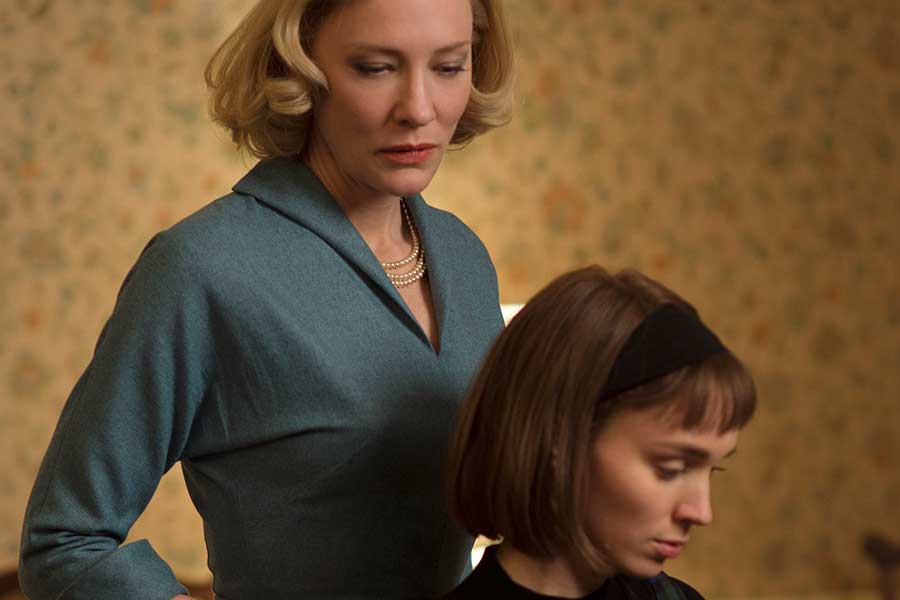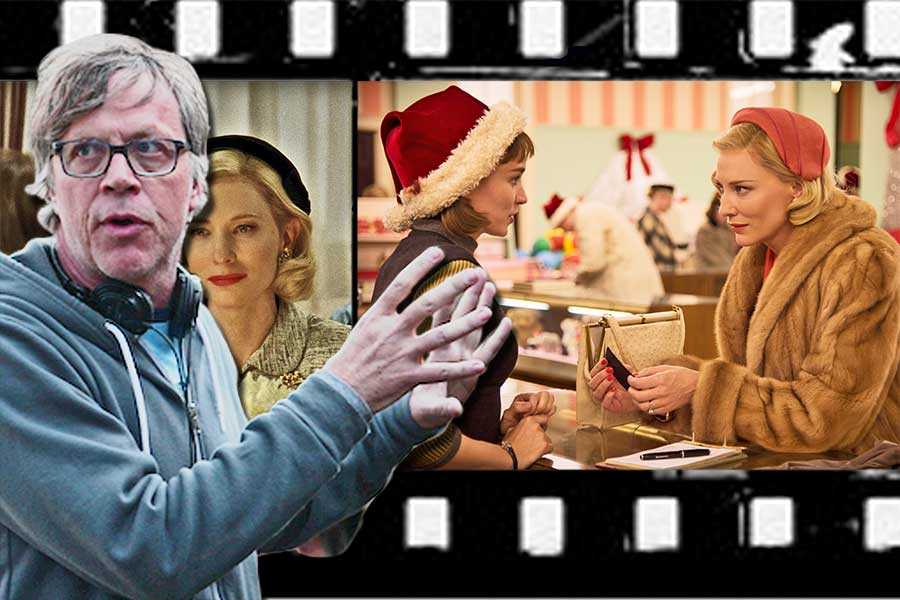Todd Haynes’ stunning romantic drama “Carol,” which opens at Ritz Theatres Dec. 25, is adapted from Patricia Highsmith’s classic lesbian novel “The Price of Salt.” This stylish and piercing character study is both a heart-rending drama and a striking romance about two women, Therese (Rooney Mara), a young department-store sales clerk, and Carol (Cate Blanchett), a married woman, coming to terms with their sexual identities in the conformist era of the 1950s.
After Therese returns a pair of gloves Carol leaves behind at her counter, Carol invites her for lunch. The women’s relationship slowly builds, with Carol having Therese over to her house and the women getting to know one another. Things move forward when Carol asks Therese to take a road trip with her. Carol wants to escape from her husband, Harge (Kyle Chandler), who is trying to gain custody of their daughter, Rindy (KK Heim). Therese wants to escape from Richard (Jake Lacey), her suffocating boyfriend looking to take their relationship to the next level.
On their travels, the attraction between the women builds. They stop in cafés, where their hands touch to communicate their burning desires. They sleep in separate hotel rooms, until their relationship culminates with an overnight stay in a midWestern hotel’s presidential suite. After their night of passion, however, a situation develops that could threaten their relationship.
The fabulous vintage costumes, cars and music from the era carry viewers into the 1950s, when such love between women was taboo. The look and feel of the film adds to Haynes’ magnificent achievement. Yet it is the emotional power of the story and the performances that make the film such a knockout. Superbly acted by Blanchett and Rooney, especially, “Carol” shows how each woman works towards securing professional, familial and sexual happiness and the cost true love entails.
Haynes, who excels at period pieces — “Far From Heaven,” “Velvet Goldmine” and the mini-series “Mildred Pierce” — met with PGN to talk about “Carol” when he was in town during the Philadelphia Film Festival.
PGN: Carol and Therese take risks. You have taken some risks in your career. What risks did you take making “Carol”?
TH: It’s always a risk because I’m doing something I’ve not done before. But it was really trying to embrace and learn from the love story as a genre and understand how a particular point of view fuels the love story.

PGN: What is the appeal of making period films?
TH: I get to live a little in each period when I make a film, and feel like I’ve actually been there, even when every piece of it, like “Far From Heaven,” is a refusal of what “authentic history” that time is about. We are solely in the artificial language of Hollywood backlot filmmaking in the moment of high melodrama. There is nothing more true than that false language. People would come out of “Far From Heaven” and say, “That’s exactly what life was really like!” Wow, I refused every element of “really like.” How much do movies affect our memories and senses of what’s real anyway?
PGN: Do you consider yourself a “woman’s director” in the way George Cukor was back in Hollywood era?
TH: I don’t know that I would identify with Cukor as much as Douglas Sirk or Rainer Werner Fassbinder, because the women in Cukor’s films are these extraordinary women who own the frame and they are outrageously unique. They are awe-inspiring, triumphant — there are exceptions, of course. I am more drawn to these stories of women who aren’t triumphant, and who aren’t awe-inspiring, and who aren’t exemplary, and who are actually very ordinary … smaller people by the end of the film than they were at the beginning.
PGN: The film is full of coded talk and discreet signals and messages. You use these elements to create a connection between the characters. How did you work with the actresses to capture that frisson?
TH: It didn’t take any work. In our rehearsal period — two weeks, which is a lot of time for a low-budget film — we would read scenes and Rooney would say, “Does she need to say that?” And we’d cut it out. And Cate would say, “We could simplify that.” It was a process of reduction, and that continued, that distillation process. It happened with [screenwriter] Phyllis Nagy in pre-production, and with me and Carter Burwell with the scoring at the end. But the other thing both of the actresses have talked about is that, for a lot of the movie, the characters are in their own worlds, and they are very different worlds. Neither actress was present for the shooting of the scenes with the other until Carol visits Therese, or Therese visits Carol. So there were not that many scenes of them together. I think in a way, their different temperaments as women, their different ages, the things they brought as actors and as people to the role, and what the roles were and what they demanded of them — the clothes and the hair and the settings that describe and define them as people — put each of them out of their comfort zones in a way, and I loved that in the book. The first draft I read had a congeniality between the two characters that wasn’t as pronounced in the book. I said to Phyllis, I loved the anxiety in the book, I want to put some of that back in. And she said, “Yes!” In trying to get the movie made, we tried to soften the edges a bit and make it more palatable for financiers, and everyone’s a little more warm and fuzzy. She was so happy to let that go.
PGN: What qualities did Cate Blanchett and Rooney Mara exude that made them the perfect choices for the role?
TH: They are amazing actors. They bring incredible integrity and serious attention to detail to everything they do. What they look like and how they manifest the purely spectral aspect of their characters to me is a huge part of their ability, but I privileged the acting more than how they looked. But knowing how they looked, I thought we’d figure all of that. But Cate has to play the image of Carol and the person of Carol at the same time. So much of it is from Therese’s perspective. Rooney has to play the young Therese and the older Therese because we shot out of order. Because the film has this narrative structure that circles back, both of them could navigate those dual challenges.
PGN: Have you ever had a love that is as strong and consuming as Carol and Therese’s?
TH: I was a Therese, and always bent out of shape over obsessive love and obsessive analysis of the outcomes and how much power the other held over me. In an earlier time in my life, after a certain bout of hardship and pain that was transformative — creatively, and in terms of life and where I am, and how I live in the world — I don’t find myself having returned to that space. Maybe I will again.
